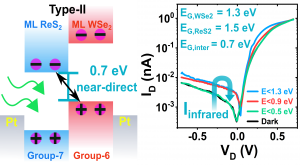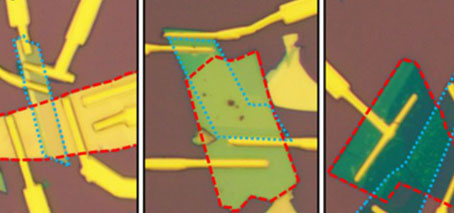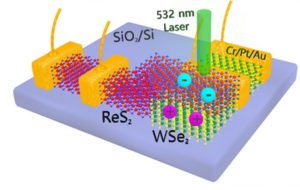- 2D vdW TMD heterostructures studied
- Study correlates interface physics to device performance

Left: band alignment in WSe2/ReS2 heterostructure. Right: Output characteristics under IR illumination.
An India-Australian theoretical and experimental study for high-performance optoelectronics has been published in Nano Letters.
The Monash University collaboration with the Indian Institute of Technology Bombay (IITB) designed and fabricated a heterostructure comprising two layered transition metal dichalcogenides (WSe2 and ReS2).
Integrating new physics in vdW heterostructures
Van-der-Waals heterostructures constructed using transition metal dichalcogenides (TMDs) are a major research focus for next-generation electronic and optoelectronic devices.
Such a heterojunction enables multifunctional operation – as a highly-responsive, high-speed photodetector as well as a photovoltaic device with large open-circuit voltage.
The device extends the functionality of its component materials by enabling zero-bias self-driven operation as well as infrared photodetection at energies lower than the bandgaps of individual materials, possible due to the interlayer bandgap.
“To date, most studies of such vdW heterostructures have focused on either device performance (eg, carrier mobility and photodetection) or heterointerface properties (via optical measurements),” says the study’s first author, Monash PhD student Abin Varghese.
“However, engineering and correlating heterointerface properties with new physics and enhanced device performance have been largely unexplored,” says Abin’s supervisor at Monash University, A/Prof Nikhil Medhekar.
The new Monash-IITB study comprehensively captures the atomistic modelling, optical, electrical as well as optoelectronic properties of a novel WSe2/ReS2 TMD heterostructure with excellent photodetection and photovoltaic performance.
Materials, device and approach
The device studied was a novel few-layer vdW heterojunction composed of group-6 TMD WSe2 and group-7 TMD ReS2.
The research team began with a theoretical study (using density functional theory, DFT) to govern the selection of materials and the optimum flake thicknesses, followed by extensive optoelectronic measurements to confirm improved device performance.
The results
The study shows that the heterojunction exhibits a near-direct type-II bandgap, which leads to excellent photodetection, superior photovoltaic and ultrafast photo-switching.
Strong interlayer coupling was found through photoluminescence (PL) studies and interlayer optical transitions across the type-II bandgap, confirming the team’s DFT predictions and extending the applicability of the vdW heterostructure in infra-red photodetection.
- sizable (0.7 eV) near-direct type-II bandgap
- interlayer IR bandgap demonstrates type-II alignment
- ultrafast response time (5 μs)
- high responsivity (3 A/W)
- large photocurrent-generation and responsivity-enhancement at the hetero-overlap region (10−100×)
- Large open-circuit voltage of 0.64 V and short-circuit current of 2.6 μA, enabling high output electrical power
- long-term air-stability, with which easy, single-contact metal fabrication process, make the construction technologically promising for next-generation optoelectronics.
The study

First author Abin Varghese is a joint PhD Student at Monash University (with FLEET CI Nikhil Medhekar) and Indian Institute of Technology Bombay, India
Near-Direct Bandgap WSe2/ReS2 Type-II pn Heterojunction for Enhanced Ultrafast Photodetection and High-Performance Photovoltaics was published in Nano Letters in February 2020 (DOI 10.1021/acs.nanolett.9b04879).
As well as Monash University and the Indian Institute of Technology Bombay (India), the study team also included researchers from the Tata Institute of Fundamental Research (India). This work was funded by the Department of Science and Technology (India)’s Swarnajayanti Fellowship, with additional funding and support from the Australian Research Council and IITB-Monash Research Academy. Device fabrication and characterisation was carried out at the IITB Nanofabrication Facility.



